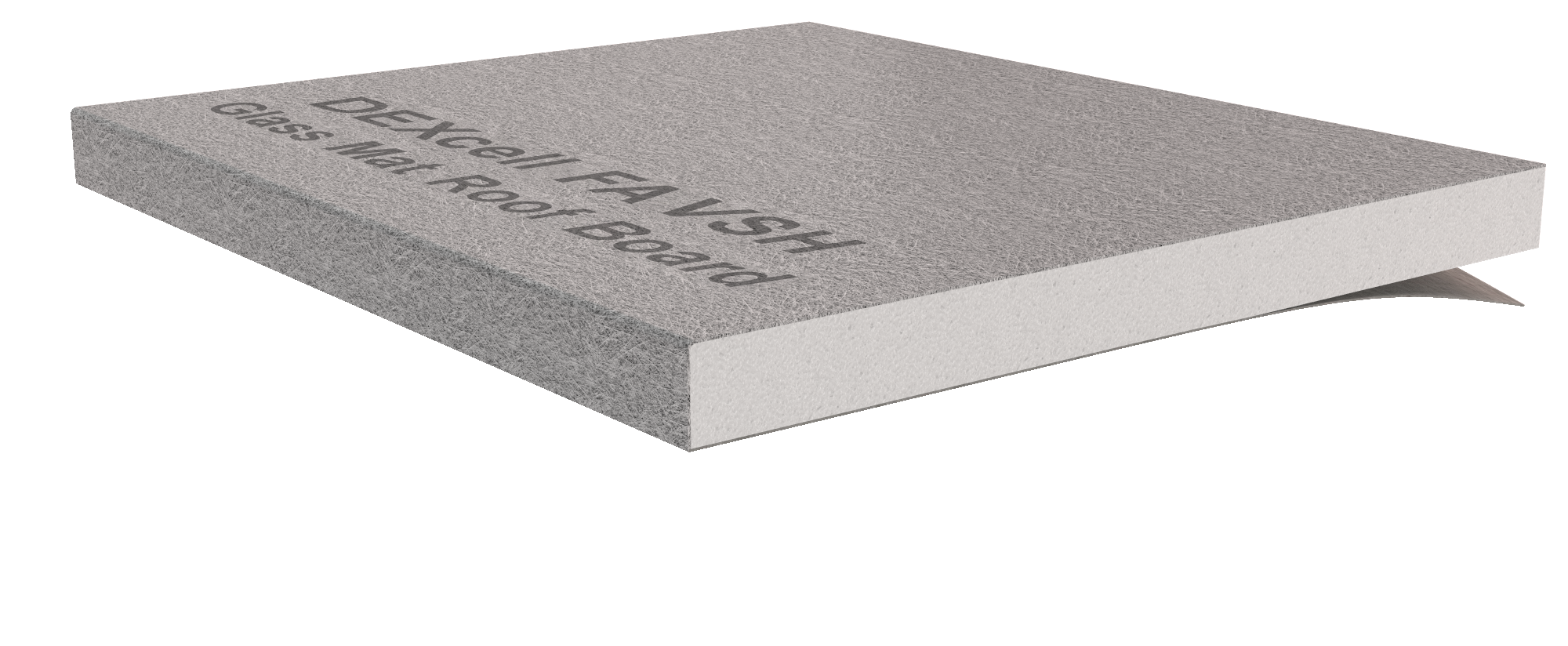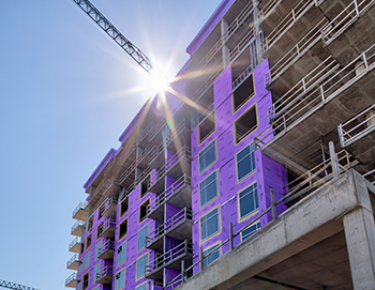 Roofing Systems
Roofing Systems
Benefits of using a coverboard on low-slope roofing
Reinforce your roof with DEXcell Roof Board products

For high-performing and long-lasting commercial facilities — such as hospitals, schools, data centers, warehouses, airports and government buildings — the roofing assembly must perform exceptionally well. Many of these buildings use a low-slope roof design, where the slant of the roof is less than 3-in-12 pitch. This means that for every horizontal foot, the roof level rises less than 3" vertically.
Not only do low-slope roofs form a critical barrier against the elements, but they also often house many of the building’s mechanical components that require routine maintenance.
As a result, the addition of a hard coverboard helps ensure the long-term viability of the roofing assembly while helping avoid leaks and damage.
“Glass-faced gypsum and cement boards can be used as protective cover boards for many low- slope roof assemblies,” said Warren Barber, product sales manager for DEXcell® Roof Board at National Gypsum. “They offer proven long-term solutions to ensure protection for the membrane above and the insulation below it. When installed correctly, cover boards can also help extend the life of a roof.”
Coverboards have been recommended by the National Roofing Contractors Association since 2000. The use of a noncombustible cover board, such as a glass-faced gypsum board, has been recommended since 2006 by both the NRCA and the Midwest Roof Contractors Association.

Benefits of using a hard cover board on a low-slope roof:
- Creates a smooth, flat surface for the membrane
- Protects insulation from foot and equipment traffic
- Improves fire ratings
- Improves thermal performance
- Prevents bubbling and blistering in hot asphalt installations
- Protects against storm and hail damage
- Increases wind uplift ratings
- Eliminates potential polyisocyanurate insulation facer delamination
DEXcell® Roof Boards, exclusively provided by National Gypsum Company, cover the entire spectrum of commercial roof applications.
“Glass-faced gypsum and cement boards can be used as protective coverboards for many low- slope roof assemblies. They offer proven long-term solutions to ensure protection for the membrane above and the insulation below it. When installed correctly, coverboards can also help extend the life of a roof.”
Warren Barber

Warren Barber
Product Sales ManagerDEXcell Roof Board at National GypsumWhat’s the best cover board for your project when polyiso insulation is in short supply?
EPS and XPS insulation boards are good substitutes when raw material shortages make polyiso insulation scarce. When used with EPS and XPS insulations, DEXcell Roof Board products create the required separation layer between the membrane and the insulation.
XPS and EPS insulation boards require a separation layer between the membrane and the insulation.
- Fire resistance: Use a fire-resistant slip-sheet, gypsum or cement coverboards based on the fire classification required.
- Solvent resistant materials: EPS and XPS can be affected by solvents. Coverboards and very often, slip-sheets, do not require gapping.
- Temperature protection under black membranes: Use coverboard to satisfy this requirement, since the temperature under a black roofing membrane will exceed the maximum use temperature for polystyrene-based insulation products.
In addition to the hail, wind and other weather-related damage, low-slope commercial roofs can suffer damage when workers — no matter how careful — are performing repairs or general maintenance.
DEXcell covers the entire spectrum of commercial roofing applications.

- DEXcell® Cement Roof Board provides superior moisture resistance, making it suitable for nearly every roof system, including fully adhered single-ply membranes, mechanically attached roof systems, modified bitumen, built-up roof systems, fluid applied, metal and spray foam. It’s also used on the roof side of parapet walls and manufactured to meet ASTM C1325.
- DEXcell® Glass Mat Roof Board is recommended for mechanically attached systems, metal roofs and wood shake underlayment. It’s also an excellent thermal and fire barrier and manufactured to meet ASTM C1177.
- DEXcell FA™ Glass Mat Roof Board has a heavy-duty coated fiberglass facer and is recommended for fully adhered single-ply membranes, modified bitumen (cold applied), fluid applied, metal and spray foam, including the roof side of parapet walls. It is manufactured to meet ASTM C1177.
- DEXcell FA VSH™ Glass Mat Roof Board is an excellent choice for applications requiring maximum hail and puncture resistance. Enhanced wind uplift, fire and moisture resistance, and dimensional stability help to protect the assembly and the building owner’s investment. It is manufactured to meet ASTM C1177 and achieves FM VSH approval for single-ply membrane assemblies.
“DEXcell roof coverboards also help reduce sound transmission from external sources,” Barber said. “Roof assemblies with high-density materials do a better job of preventing low, rumbling transportation noises from coming inside, and DEXcell cement and gypsum roof coverboards rank among the densest materials that can be incorporated into roof assemblies.”
For more information about which DEXcell product to specify and technical details about the products, download the technical guide or contact your region’s National Gypsum construction design manager.
Be the first to hear of new NGConnects blog posts by subscribing here for early access.










